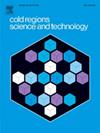Mapping snow gliding distances: Bridging modelled and field observations
IF 3.8
2区 工程技术
Q1 ENGINEERING, CIVIL
引用次数: 0
Abstract
Snow gliding affects soil erosion patterns and depends on various factors such as slope angle, precipitation amount, and vegetation roughness. Snow gliding distance can be assessed through measurement or modeling. However, the comparison of measured with modelled data remains limited due to the scarcity of measured data. We present a long-term dataset (2010−2021) of measured snow gliding distances for two Swiss alpine Valleys (Urseren and Val Piora) using glide shoes to address this gap. We also predicted snow gliding between 2010 and 2021 using the spatial snow gliding distance model developed by Leitinger et al. (2018). Our analysis of the measured data indicates that sites with a north aspect generally exhibit shorter snow gliding distances than those facing south. Moreover, we observed an increase in snow gliding distance with steeper slope angles and a decrease with a higher roughness coefficient. Comparing measured and modelled values, the R2 and Concordance Correlation Coefficient (CCC) values are 0.23 and 0.12 for the Urseren Valley and 0.24 and 0.35 for the Val Piora. Generally, the model tended to predict higher values than the measured data for both Valleys, potentially due to the large small-scale variability observed in the replicates of the measured data that cannot be caught with large-scale models. This variability highlights the dynamic nature of snow gliding distance, making it challenging to model or measure accurately. Furthermore, a covariate importance analysis revealed precipitation and slope angle as the dominant drivers of modelled snow gliding distances versus vegetation roughness (a rather local feature) for measured values.
求助全文
约1分钟内获得全文
求助全文
来源期刊

Cold Regions Science and Technology
工程技术-地球科学综合
CiteScore
7.40
自引率
12.20%
发文量
209
审稿时长
4.9 months
期刊介绍:
Cold Regions Science and Technology is an international journal dealing with the science and technical problems of cold environments in both the polar regions and more temperate locations. It includes fundamental aspects of cryospheric sciences which have applications for cold regions problems as well as engineering topics which relate to the cryosphere.
Emphasis is given to applied science with broad coverage of the physical and mechanical aspects of ice (including glaciers and sea ice), snow and snow avalanches, ice-water systems, ice-bonded soils and permafrost.
Relevant aspects of Earth science, materials science, offshore and river ice engineering are also of primary interest. These include icing of ships and structures as well as trafficability in cold environments. Technological advances for cold regions in research, development, and engineering practice are relevant to the journal. Theoretical papers must include a detailed discussion of the potential application of the theory to address cold regions problems. The journal serves a wide range of specialists, providing a medium for interdisciplinary communication and a convenient source of reference.
 求助内容:
求助内容: 应助结果提醒方式:
应助结果提醒方式:


